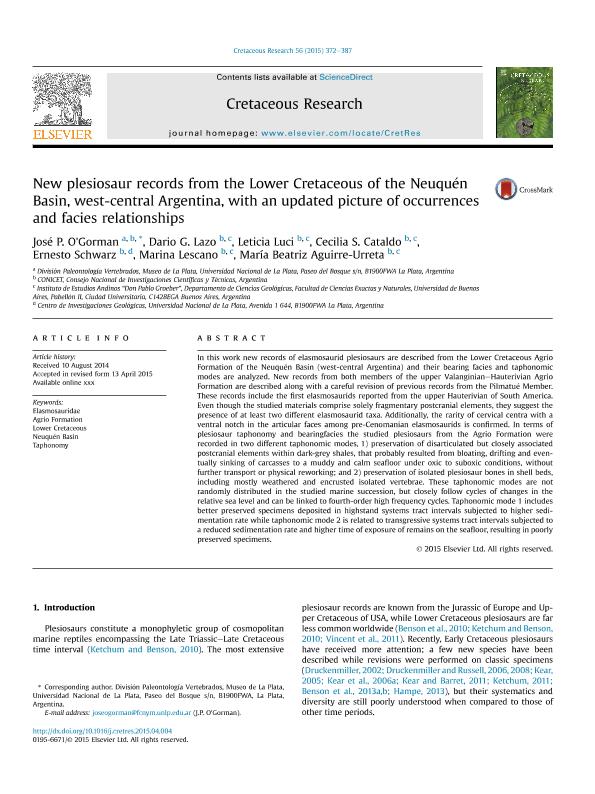Artículo
New plesiosaur records from the Lower Cretaceous of the Neuquén Basin, west-central Argentina, with an updated picture of occurrences and facies relationships
O'gorman, Jose Patricio ; Lazo, Dario Gustavo
; Lazo, Dario Gustavo ; Luci, Leticia
; Luci, Leticia ; Cataldo, Cecilia Soledad
; Cataldo, Cecilia Soledad ; Schwarz, Ernesto
; Schwarz, Ernesto ; Lescano, Marina Aurora
; Lescano, Marina Aurora ; Aguirre-Urreta, Maria Beatriz
; Aguirre-Urreta, Maria Beatriz
 ; Lazo, Dario Gustavo
; Lazo, Dario Gustavo ; Luci, Leticia
; Luci, Leticia ; Cataldo, Cecilia Soledad
; Cataldo, Cecilia Soledad ; Schwarz, Ernesto
; Schwarz, Ernesto ; Lescano, Marina Aurora
; Lescano, Marina Aurora ; Aguirre-Urreta, Maria Beatriz
; Aguirre-Urreta, Maria Beatriz
Fecha de publicación:
09/2015
Editorial:
Academic Press Ltd - Elsevier Science Ltd
Revista:
Cretaceous Research
ISSN:
0195-6671
Idioma:
Inglés
Tipo de recurso:
Artículo publicado
Clasificación temática:
Resumen
In this work new records of elasmosaurid plesiosaurs are described from the Lower Cretaceous Agrio Formation of the Neuquén Basin (west-central Argentina) and their bearing facies and taphonomic modes are analyzed. New records from both members of the upper Valanginian-Hauterivian Agrio Formation are described along with a careful revision of previous records from the Pilmatué Member. These records include the first elasmosaurids reported from the upper Hauterivian of South America. Even though the studied materials comprise solely fragmentary postcranial elements, they suggest the presence of at least two different elasmosaurid taxa. Additionally, the rarity of cervical centra with a ventral notch in the articular faces among pre-Cenomanian elasmosaurids is confirmed. In terms of plesiosaur taphonomy and bearingfacies the studied plesiosaurs from the Agrio Formation were recorded in two different taphonomic modes, 1) preservation of disarticulated but closely associated postcranial elements within dark-grey shales, that probably resulted from bloating, drifting and eventually sinking of carcasses to a muddy and calm seafloor under oxic to suboxic conditions, without further transport or physical reworking; and 2) preservation of isolated plesiosaur bones in shell beds, including mostly weathered and encrusted isolated vertebrae. These taphonomic modes are not randomly distributed in the studied marine succession, but closely follow cycles of changes in the relative sea level and can be linked to fourth-order high frequency cycles. Taphonomic mode 1 includes better preserved specimens deposited in highstand systems tract intervals subjected to higher sedimentation rate while taphonomic mode 2 is related to transgressive systems tract intervals subjected to a reduced sedimentation rate and higher time of exposure of remains on the seafloor, resulting in poorly preserved specimens.
Palabras clave:
AGRIO FORMATION
,
ELASMOSAURIDAE
,
LOWER CRETACEOUS
,
NEUQUÉN BASIN
,
TAPHONOMY
Archivos asociados
Licencia
Identificadores
Colecciones
Articulos(CCT - LA PLATA)
Articulos de CTRO.CIENTIFICO TECNOL.CONICET - LA PLATA
Articulos de CTRO.CIENTIFICO TECNOL.CONICET - LA PLATA
Articulos(CIG)
Articulos de CENTRO DE INVEST.GEOLOGICAS (I)
Articulos de CENTRO DE INVEST.GEOLOGICAS (I)
Articulos(IDEAN)
Articulos de INSTITUTO DE ESTUDIOS ANDINOS "DON PABLO GROEBER"
Articulos de INSTITUTO DE ESTUDIOS ANDINOS "DON PABLO GROEBER"
Citación
O'gorman, Jose Patricio; Lazo, Dario Gustavo; Luci, Leticia; Cataldo, Cecilia Soledad; Schwarz, Ernesto; et al.; New plesiosaur records from the Lower Cretaceous of the Neuquén Basin, west-central Argentina, with an updated picture of occurrences and facies relationships; Academic Press Ltd - Elsevier Science Ltd; Cretaceous Research; 56; 9-2015; 372-387
Compartir
Altmétricas



